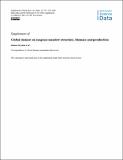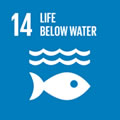Por favor, use este identificador para citar o enlazar a este item:
http://hdl.handle.net/10261/295998COMPARTIR / EXPORTAR:
 SHARE SHARE
 CORE
BASE CORE
BASE
|
|
| Visualizar otros formatos: MARC | Dublin Core | RDF | ORE | MODS | METS | DIDL | DATACITE | |

| Título: | Global dataset on seagrass meadow structure, biomass and production |
Autor: | Strydom, Simone; McCallum, Roisin; Lafratta, Anna; Webster, Chanelle; O'Dea, Caitlyn M.; Said, Nicole E.; Dunham, Natasha; Inostroza, Karina; Salinas, Cristian; Billinghurst, Samuel; Phelps, Charlie M.; Campbell, Connor; Gorham, Connor; Bernasconi, Rachele; Frouws, Anna M.; Werner, Axel; Vitelli, Federico; Puigcorbé, Viena CSIC ORCID; D'Cruz, Alexandra; McMahon, Kathryn M.; Robinson, Jack; Huggett, Megan J.; McNamara, Sian; Hyndes, Glenn; Serrano, Oscar CSIC ORCID CVN | Fecha de publicación: | feb-2023 | Editor: | Copernicus Publications | Citación: | Earth System Science Data 15(1): 511-519 (2023) | Resumen: | Seagrass meadows provide valuable socio-ecological ecosystem services, including a key role in climate change mitigation and adaption. Understanding the natural history of seagrass meadows across environmental gradients is crucial to deciphering the role of seagrasses in the global ocean. In this data collation, spatial and temporal patterns in seagrass meadow structure, biomass and production data are presented as a function of biotic and abiotic habitat characteristics. The biological traits compiled include measures of meadow structure (e.g. percent cover and shoot density), biomass (e.g. above-ground biomass) and production (e.g. shoot production). Categorical factors include bioregion, geotype (coastal or estuarine), genera and year of sampling. This dataset contains data extracted from peer-reviewed publications published between 1975 and 2020 based on a Web of Science search and includes 11 data variables across 12 seagrass genera. The dataset excludes data from mesocosm and field experiments, contains 14 271 data points extracted from 390 publications and is publicly available on the PANGAEA® data repository (https://doi.org/10.1594/PANGAEA.929968; Strydom et al., 2021). The top five most studied genera are Zostera, Thalassia, Cymodocea, Halodule and Halophila (84 % of data), and the least studied genera are Phyllospadix, Amphibolis and Thalassodendron (2.3 % of data). The data hotspot bioregion is the Tropical Indo-Pacific (25 % of data) followed by the Tropical Atlantic (21 %), whereas data for the other four bioregions are evenly spread (ranging between 13 and 15 % of total data within each bioregion). From the data compiled, 57 % related to seagrass biomass and 33 % to seagrass structure, while the least number of data were related to seagrass production (11 % of data). This data collation can inform several research fields beyond seagrass ecology, such as the development of nature-based solutions for climate change mitigation, which include readership interested in blue carbon, engineering, fisheries, global change, conservation and policy | Descripción: | 9 pages, 6 figures, 1 table, supplement https://doi.org/10.5194/essd-15-511-2023-supplement.-- Data availability: Data are archived in the data repository PANGAEA (https://doi.org/10.1594/PANGAEA.929968) (Strydom et al., 2022).-- Code availability: R scripts used to generate figures and maps can be found in the Supplement | Versión del editor: | https://doi.org/10.5194/essd-15-511-2023 | URI: | http://hdl.handle.net/10261/295998 | DOI: | 10.5194/essd-15-511-2023 | ISSN: | 1866-3508 | E-ISSN: | 1866-3516 |
| Aparece en las colecciones: | (ICM) Artículos (CEAB) Artículos |
Ficheros en este ítem:
| Fichero | Descripción | Tamaño | Formato | |
|---|---|---|---|---|
| Strydom_et_al_2023.pdf | 1,93 MB | Adobe PDF |  Visualizar/Abrir | |
| Strydom_et_al_2023_suppl.pdf | 430,2 kB | Adobe PDF |  Visualizar/Abrir |
CORE Recommender
SCOPUSTM
Citations
1
checked on 20-abr-2024
WEB OF SCIENCETM
Citations
1
checked on 23-feb-2024
Page view(s)
45
checked on 03-may-2024
Download(s)
84
checked on 03-may-2024
Google ScholarTM
Check
Altmetric
Altmetric
Este item está licenciado bajo una Licencia Creative Commons



